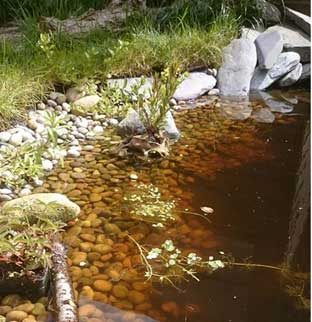Urbanisation and farming methods have resulted in many of England’s natural wetlands disappearing. You and I can help wildlife by building ponds in our back gardens. Advantages to building a pond for wildlife benefit you and I too by way of very effective pest control. Yes, frogs, toads, dragonflies, bats and birds attracted to water thrive on the nutritional value of pests!
Over the past decade there has been an increase in the popularity of garden ponds. The way we build ponds today using pond liners or prefabricated materials is very different to how they were constructed in the days of the ornamental Greek and Roman ponds. But our motivation is still the same as our ancestors who sort a piece of paradise where they could go to relax and watch the graceful movements of fish through the water.
There is one additional motivation today that people of the past weren’t mindful of (because the world was in a very different state then) and that is to create a safe environment for small creatures. Wildlife is now constantly threatened by the development of concrete structures to cope with the ever growing human population. As humans etch their way further and further into places that wildlife once called ‘home’, we need to supplement the lose of natural homes with man-made ones. Of all the habitats you can create to help wildlife, a pond is one of the most effective. Ponds with a range of different features and habitats tend to attract a greater variety of wildlife.
Features added above pond liner that attract wildlife
- gently sloping sides and ‘beaches’

- muddy marginal area
- marginal plants
- shallow water
- sunlight – or dabbled sunlight
Marginal plants such as reeds, bull rushes, yellow iris and water mint that are found to grow at the edge of ponds provide shelter for frogs, tadpoles and newts.
Dragonflies and damselflies thrive in open, sunny ponds.
Floating leaved plants such as water lily and submerged plants such as hornwort provide food and water for water snails.
Designing your wildlife pond
- Make your pond as big as possible to create many and varied habitats. The Wildlife Trust suggests a pond 1m wide by 2m long to be an ideal size.
- Ensure some edges are shallow and sloping to allow animals easy access (as shown in the photo image).
- Add native plants from other garden ponds or garden centres. Never take plants from the wild.
When you have finished building your pond don’t be tempted to transfer creatures such as frogs and newts from other ponds or take spawn from the wild, which can spread disease. Insects, amphibians and invertebrates will find your pond surprisingly quickly on their own.
Pond liners are an easy way of containing water for wildlife ponds particularly where the ground is porous. The pond liner does not need to detract from the natural look of your pond. Cover it with smooth surfaced pebbles as shown in the attached photograph. Rubber pond liners such as Epalyn (EPDM) or Butyl are non-toxic to wildlife and don’t leach chemicals into the water. The liner material is thick, flexible and resistant to UV rays so will stand up to sunny conditions and the presence of wildlife for more than 25 years.
Creating a pond for wildlife will bring you heaps of enjoyment.
“Of all the habitats you can create to help wildlife, a pond is probably the most effective.” as quoted by the RSPB






An exciting discussion is worth comment. I feel that you simply ought to write a lot more on this subject, it could possibly not be a taboo topic but typically people today aren’t enough to speak on such topics. To the subsequent. Cheers
You produced some decent points there. I looked on the web for the problem and found most people will go along with along with your web site.
Hey there, You have done a fantastic job. I’ll definitely digg it and personally suggest to my friends. I’m confident they will be benefited from this website.
I love the info on your internet site. With thanks!.
Robbie Keane http://annunci.camerealondra.com/author/davidawoods/
Thank you so much for sharing your awesome site
Frank Lampard http://ts-free.com/bss/home.php?mod=space&uid=671176&do=profile&from=space
Wonderful Webpage, Continue the beneficial work. Appreciate it!.
Alan Shearer http://itaircnet.altervista.org/tmp/index.php?page=User&userID=180189